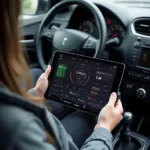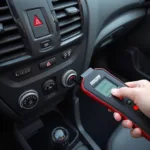OBD2 Bluetooth and USB scanners have revolutionized car diagnostics, offering a convenient and affordable way to understand your vehicle’s health. Whether you’re a seasoned mechanic or a car enthusiast, choosing the right OBD2 interface can significantly impact your diagnostic experience. This guide explores the world of OBD2 Bluetooth and USB scanners, helping you understand the nuances, advantages, and how to choose the perfect tool for your needs.
Understanding OBD2 Bluetooth and USB Interfaces
OBD2, or On-Board Diagnostics II, is a standardized system that allows external devices to access a vehicle’s diagnostic data. Bluetooth and USB interfaces provide the bridge between your car’s OBD2 port and your diagnostic device, typically a smartphone, tablet, or laptop. Understanding the difference between these two interfaces is crucial for selecting the optimal tool. how to connect obd2 elm327 will provide more insight on this.
OBD2 Bluetooth Scanners: Wireless Freedom
OBD2 Bluetooth scanners transmit data wirelessly, offering unparalleled convenience. You simply plug the adapter into your car’s OBD2 port and pair it with your device via Bluetooth. This eliminates the clutter of cables and allows you to move freely around your vehicle while diagnosing.
OBD2 USB Scanners: Wired Reliability
OBD2 USB scanners offer a wired connection, ensuring a stable and reliable data stream. They are often preferred for tasks requiring continuous data monitoring or when dealing with complex diagnostic procedures.
Choosing the Right OBD2 Bluetooth and USB Scanner
Selecting the right scanner depends on your specific needs and budget. Several factors come into play:
- Vehicle Compatibility: Ensure the scanner supports your vehicle’s make, model, and year.
- Software Compatibility: Check if the scanner is compatible with the diagnostic software you intend to use. Some scanners come with their own dedicated apps.
- Features: Consider features like data logging, real-time monitoring, and support for specific diagnostic protocols.
- Budget: OBD2 scanners range in price from budget-friendly options to professional-grade tools.
For an overview of the best OBD2 tablets, visit best obd2 tablet.
Using OBD2 Bluetooth and USB Scanners
Using an OBD2 scanner, whether Bluetooth or USB, is relatively straightforward:
- Locate your vehicle’s OBD2 port, typically located under the dashboard on the driver’s side.
- Plug the OBD2 scanner into the port.
- Turn on your vehicle’s ignition (do not start the engine).
- Pair the Bluetooth scanner with your device, or connect the USB scanner to your computer.
- Launch your diagnostic software and begin scanning. Learn more at how to use the elm 327 obd2 scanner.
You can find helpful information on obd2 elm327 schematic.
Expert Insight: “The key to successful diagnostics lies in understanding the data. A good OBD2 scanner combined with reliable software can empower you to pinpoint issues accurately,” says Robert Johnson, a certified automotive technician with over 20 years of experience. “Don’t underestimate the importance of choosing the right interface for your workflow.”
Advanced Features and Considerations
Some OBD2 scanners offer advanced features, such as bi-directional communication, allowing you to perform certain tests and resets. For information on chipsets for scanning and programming, see obd2 chip set to scan and program.
Expert Insight: “While basic OBD2 scanners are sufficient for reading and clearing codes, investing in a more advanced tool can open up a whole new world of diagnostic capabilities,” adds Maria Sanchez, an automotive engineer specializing in diagnostic systems.
In conclusion, OBD2 Bluetooth and USB scanners provide essential tools for car diagnostics, offering varying levels of convenience and functionality. By understanding your specific needs and considering the factors discussed, you can choose the perfect OBD2 interface to empower your automotive diagnostic journey.
FAQ
- What is the difference between OBD2 Bluetooth and USB? Bluetooth offers wireless convenience, while USB provides a wired, stable connection.
- Can I use any OBD2 scanner with my car? Ensure compatibility with your vehicle’s make, model, and year.
- What software do I need to use with an OBD2 scanner? Many scanners come with dedicated apps, or you can use third-party software.
- How much do OBD2 scanners cost? Prices range from budget-friendly to professional-grade.
- Can I use an OBD2 scanner to program my car? Some advanced scanners offer programming capabilities.
- Where can I find my car’s OBD2 port? It’s typically located under the dashboard on the driver’s side.
- What if my OBD2 scanner doesn’t work? Check connections, compatibility, and consult the user manual.
For any assistance, contact us via WhatsApp: +1(641)206-8880, Email: [email protected] or visit us at 789 Elm Street, San Francisco, CA 94102, USA. Our customer support team is available 24/7.

